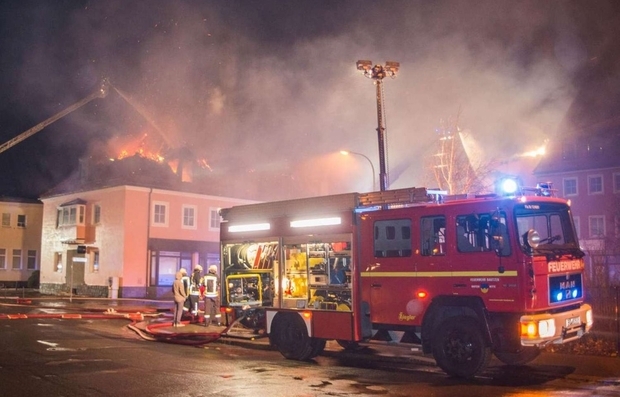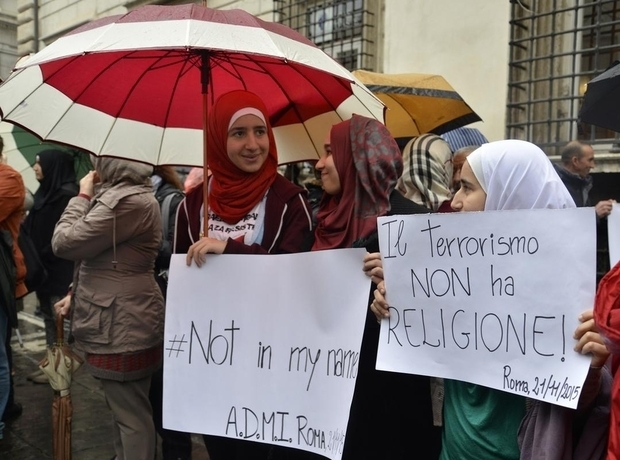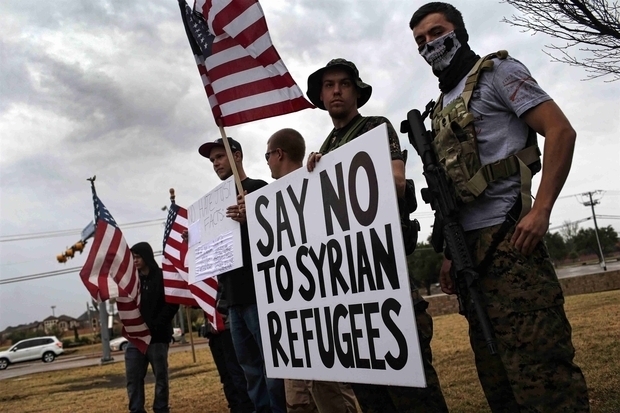
How the EU conceals far-right acts of terrorism against Muslims
The double standards which structure the media coverage, the research and policies on terrorism are now well-known. They are visible daily, empirically verifiable, and amply documented.
To summarise, the reality of terrorism is systematically and doubly distorted. First, what we consider "terrorism" is usually reduced to focus only on those acts by non-state actors like al-Qaeda or Islamic State (IS) group. By itself, this enormously distorts reality as state terrorism is by far the worst kind of all.
But then terrorism is further restricted as it is attributed - through various narratives and representations - solely to "Islamic Jihadism".
The result is a grossly biased, distorted and, above all, perfectly inaccurate perception of the phenomenon – which seems to be the goal.
‘Terrorism’, a variable geometry word
The excellent and incisive American academic Juan Cole has concisely and humorously drawn up the list of these double standards which we can readily observe.
White terrorists are generally not terrorists but simple "murderers" or "criminals", while their Arab and/or Muslim counterparts are immediately perceived and categorised as "terrorists". Similarly, the former are always presented as isolated individuals with no relation whatsoever to any other person or group, while "jihadists" are inevitably part of a group, if not a vast planetary "Islamist" plot, even when it is clear that the attacker is a perfectly isolated individual, a loner cut off from everything.
A white and/or Christian terrorist will never be presented as typical of whites or Christians. On the other hand, an Arab will always be representative of the hypothetical flaws of the society to which he supposedly belongs. A Muslim who attacks other people shouting “Allahu Akbar” is therefore automatically regarded as emblematic of the “disease of Islam”, its so-called “innate violence”. All Muslims and their spiritual authorities, imams and others, will thus be asked to “denounce” his act, “to make their voices heard”, “to fight the violence brewing within them”.
Guilt and collective responsibility therefore apply only when the terrorist is a Muslim. By the way, that expression "Christianist terrorism"? Unlike "Islamist terrorism", it does not exist.
In addition, jihadists are always described as perfectly sane and in control of their actions; while others, especially those who kill or seek to kill Muslims, are usually presented as lunatics, maniacs and clinical cases that fall primarily within the field of psychiatry.
Most importantly, attacks by far-right extremists are never linked to a collective culture, certain dominant discourses, an ideology (anti-immigrant, Islamophobic, racialist, nationalist or other) despite the fact that those are constructed and propagated consistently by ideologists such as the writer Bat Ye’Or, with her insane “theories” on Eurabia and Europe’s "Islamisation"; blogs like Riposte Laïque or Fdesouche, major media outlets such as Valeurs Actuelles, Islamophobic intellectuals like Éric Zemmour or Renaud Camus, and influential political figures such as Donald Trump, Geert Wilders or Oskar Freysinger.
These ideologies, speeches, media and political leaders are never, at least legally, seen as responsible for anti-Muslim and anti-immigrant terrorism, while we consider "Salafism", "radical Islamism" (or simply "political" Islamism), or even Islam as a whole, as being the sources, origins or “antechambers” of jihadism – ideologies that must then be eradicated, including by expelling those who propagate them ("radical" imams), and closing places of worship on the basis of mere suspicions and without any proof.
The use of the word "terrorism" and the terms associated with it ("radicalisation", "extremism", etc) is therefore always highly selective. Its characterisation and treatment by our states responds to a variable geometry, and its criteria change randomly according to the attackers and the victims.
An emblematic case in point: Dylann Roof
Examples are legion. One of the most glaring is that of Dylann Roof, a 19-year-old American who, on 18 June 2015, killed nine black people in their church in Charleston, South Carolina, right in the middle of the mass in order to trigger, according to documents found at his home, “a war of races” in the United States.
Roof, a white supremacist who is classic in his ideology and culture, belonged to the Southern Christian Confederate movement. In his home, the investigators found loads of documents, pamphlets, flags, photographs, and supremacist and neo-Nazi manifestos, including his own website "The Last Rhodesian", where he proudly posed with the symbols of these movements and explained his motives and models, such as Apartheid and segregationist South Africa.
Despite all this, including his own confession about the racist and racial motivation of his killings, the US authorities and most of the major Western media refused to talk about a terrorist act. Obama described the killing as a “senseless shooting”. Major media outlets, both in Europe and the US, deployed a wealth of linguistic inventiveness (and hypocrisy) to avoid having to describe Roof for what he quite evidently was – a white Christian supremacist terrorist – and instead portrayed him as a murderer, an extremist, and even, for the New York Times, a hellish visitor!
It is easy to imagine the difference in the media, police, political and judicial treatment if, instead of a white Christian supremacist and his black victims, the murderer had been a Muslim Arab who had executed nine white people in their church shouting “Allahu Akbar” before the police found videos and texts of allegiance to IS in his home!
Dylann Roof was tried and sentenced to death in 2017, but for murder and “hate crimes”, not for terrorism, although this is what he is guilty of.
This is an example of how our media, police, political and judicial institutions deny and evacuate - including from official statistics - forms of non-"Islamist" terrorism, even among the most serious ones. Meanwhile, ideologies, opinion leaders and groups like the Tea Party, who create and nurture this kind of terrorism, can continue on while the authorities lash out at jihadism and its so-called "sources" in Salafism, "radical" mosques, the Muslim Brotherhood, and others.
Despite the lies, the ‘jihadist’ threat is still decreasing
Despite its alarmist rhetoric (used, of course, to justify its budget), the latest Europol report, “European Union Terrorism. Situation and Trend 2017”, shows that as for previous years, this terrorist threat with which we frighten our populations actually kills very little and that nothing, no cause of mortality, violent or not, kills less than that in Europe: 142 victims in 2016 out of the 28 EU countries’ 510 million inhabitants. We wish all other causes of violent death, from accidents to homicides, were at such a low level.
We also see how our leaders, media, pseudo-experts in terrorism and talking heads on television lie to us on both the scale and trends of this threat. While everyone, every day, hammers home the message that it has never been so high and that it keeps getting worse, the reality is the exact opposite, as stated by the Europol report: “The total number of 142 attacks is a continuation of a downward trend that started in 2014 when there were 226 attacks, followed by 211 in 2015."
You will never hear a politician telling you such a thing. You will never see these proven facts make the headlines of newspapers and magazines, fearmongering being so essential to rulers as a way of governance, and paranoid hysteria around terrorism so useful to some people.
Even more interesting: while we are told that the jihadist threat is now affecting everyone and that no country is immune, we find out that only three out of the 28 EU member states (France, Belgium, and Germany) have suffered one or more such attacks on their soil, whether successful or not, during the period under review (Europol report, page 49).
The vast majority of the EU, 25 countries out of 28, have not suffered any, even taking into account the failed or defeated attacks, despite the Syrian situation and the war against IS, which for two years have greatly exacerbated the threat.
How the EU excludes terrorist acts against Muslims, migrants and refugees from its figures
More importantly, a careful reading of the report tells us in just one paragraph, another thing that is truly flabbergasting, and confirms what has been suspected for some time: member states (with one exception, the Netherlands) do not consider “violent assaults by right-wing extremist individuals and groups […] targeting asylum seekers and ethnic minorities in general” to be terrorist acts!
They therefore do not include them in their figures, statistics, press releases and reports. The same applies to Europol, which builds on the data provided by these member states. Breathtaking.
Second surprise: the definition – which is also the definition adopted by the EU member states – does not justify in any way such a selective exclusion of “violent assaults by right-wing extremist individuals and groups […] targeting asylum seekers and ethnic minorities in general”. On the contrary.
Indeed, we can read that a terrorist act consists of “intentional acts which, given their nature or context, may seriously damage a country or an international organisation when committed with the aim of: seriously intimidating a population, or unduly compelling a government or international organisation to perform or abstain from performing an act, or seriously destabilising or destroying the fundamental political, constitutional, economic or social structures of a country or an international organisation".
Yet that is the exact definition, point by point, of these “violent assaults by right-wing extremist individuals and groups […] targeting asylum seekers and ethnic minorities in general”!
We therefore know that for the EU authorities and member states, ploughing into a crowd shouting “Allahu Akbar” is indeed terrorism, but burning alive Syrian refugees by setting fire to their reception centres (which happens regularly in Germany, Sweden and elsewhere), for example, is not.
The exclusion of such attacks against refugees and minorities from the ‘terrorism’ category is totally unjustifiable. It results indeed in camouflaging the reality and the scale (which is increasing, contrary to the diminishing ‘jihadism’) of terrorism against these groups and populations. It also completely distorts the statistics, speeches, and public perceptions of the phenomenon.
This deliberate choice is even more serious and unjustifiable given the context: a vertiginous surge of this type of attacks, recognised by Europol itself: “Refugees and ethnic minorities in the EU are facing increased violence”, and this wave of crimes is meant to “seriously intimidate sections of the population”. This constitutes, according to its own definition and that of the EU, one of the motivations and sufficient criteria for classifying a crime as a "terrorist act".
Notwithstanding, the report argues that they “do not qualify as terrorism or violent extremism and are therefore not reported by member states and consequently not included in the figures”. Appalling.
All the more so as a little further down the report (again in a small footnote readable only with a microscope), one finds the following: “An average of nearly 10 attacks a day were carried out on refugees in Germany in 2016, according to Germany’s Interior Ministry, as reported in open source media”. In other words, for that year alone, almost 3,500 attacks against the refugee population were committed, and as many potential terrorist acts excluded from the statistics.
However, worse than this, there is distortion and denial: far-right Islamophobic, racist, anti-immigrant and anti-refugee terrorists are thus not only exempted from being labelled "terrorist" but – which is even more serious – they are also let off the hook from being investigated and from undergoing court proceedings that are launched against suspects and culprits when a violent crime, assault or murder is regarded as a terrorist act.
This terrorism, of which the mere figure above on Germany suggests that it might well be the most widespread of all, is at the same time protected from the attention, special measures, and public policies it could be subject to like "jihadism" is.
We now have the proof from Europol itself that the bulk of, if not all, far-right terrorism against refugees (Muslims and others) and ethnic minorities in Europe is almost systematically and deliberately excluded from the figures, statistics, speeches and public reports of the EU member states. This, in turn, means that these terrorists are protected from the anti-terrorist policies that could target them as hard as their jihadist counterparts.
- Alain Gabon is an associate professor of French based in the United States and the head of the French Department at Virginia Wesleyan University. He has written numerous papers and articles on contemporary France and on Islam in Europe and throughout the world. His work has been published by academic journals, think tanks such as Great Britain’s Cordoba Foundation, and mainstream media outlets such as Saphirnews and Les cahiers de l'Islam. His essay entitled “Islamic radicalization and the jihadist threat in the West: the double myth” was published in September 2016 by the Cordoba Foundation.
The views expressed in this article belong to the author and do not necessarily reflect the editorial policy of Middle East Eye.
Photo: Fire fighters try to extinguish a fire in an old hotel under reconstruction to become a reception centre for asylum seekers, on 21 February 2016, in Bautzen, near Dresden, eastern Germany. The incident did not cause any casualties, as the centre was not yet inhabited. The anti-refugee comments made by some passers-by on the site shocked public opinion (AFP).
Translated from French: http://www.middleeasteye.net/fr/opinions/comment-l-ue-camoufle-le-terrorisme-dextr-me-droite-contre-les-musulmans-440004612
New MEE newsletter: Jerusalem Dispatch
Sign up to get the latest insights and analysis on Israel-Palestine, alongside Turkey Unpacked and other MEE newsletters
Middle East Eye delivers independent and unrivalled coverage and analysis of the Middle East, North Africa and beyond. To learn more about republishing this content and the associated fees, please fill out this form. More about MEE can be found here.






